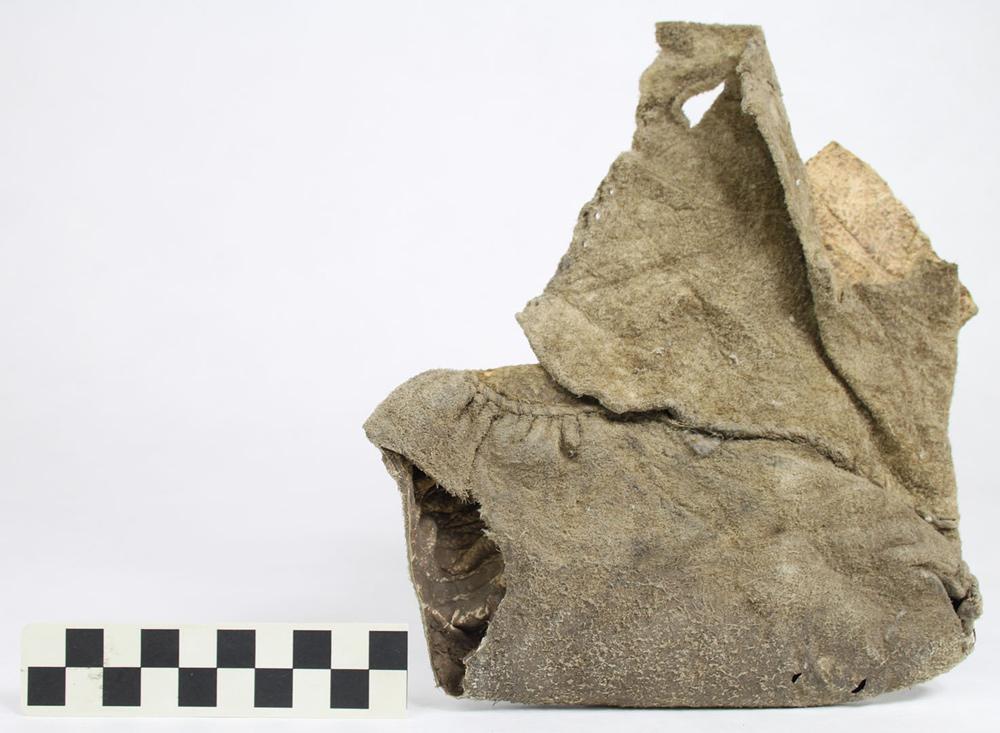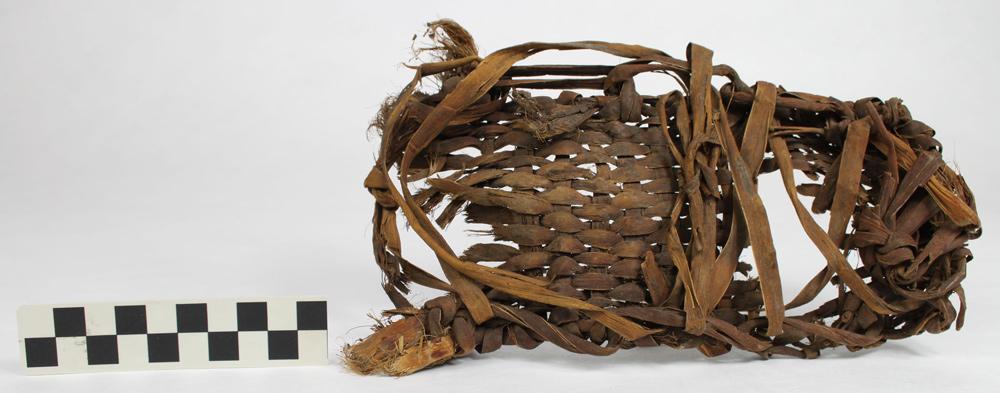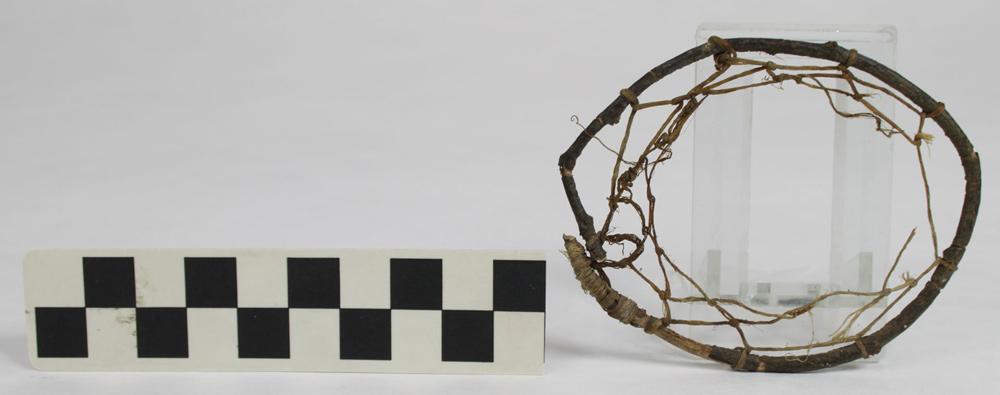Franktown Cave
Full Article
Located two and a half miles southwest of Franktown, Franktown Cave is a prehistoric archaeological site in a large rockshelter that contained artifacts from prehistoric occupations over 8,000 years. Some of the findings include rare perishable artifacts manufactured from hide, wood and fiber, and plant material. Preservation of perishable artifacts in archaeological sites is extremely rare in general and exceptional in eastern Colorado. This makes Franktown Cave a significant archaeological site that provides invaluable and unique information on prehistoric people not available from other sites.
Franktown Cave is on the north edge of the Palmer Divide, an area of grassland, scrub oak, and open ponderosa pine forest above 6,000 feet in elevation. The area forms the drainage divide between the South Platte River to the north and the Arkansas River to the south. The cave developed at the contact between two sedimentary rock units: the harder Castle Rock Conglomerate above and the softer, finer-textured Dawson Arkose formation below. At Franktown Cave the softer Dawson Arkose eroded from under the Castle Rock Conglomerate, leaving an overhang that was attractive as a shelter to prehistoric people and dry enough to preserve delicate artifacts made from perishable materials.
Early Investigations
The Franktown Cave collection at the University of Denver (DU) contains materials from five episodes of archaeological investigation: four excavations and a one-day visit. Hugh Capps, a 1941 graduate of DU, was the first person to perform a scientific excavation at Franktown Cave. In 1949 and 1952, Professor Arnold Withers of DU’s Department of Anthropology supervised students in the excavation of two adjacent areas. From 1956 to 1957, Gerold Thompson, a graduate student working under Professor Withers’s supervision, led excavations within a grid system different from that of the previous Withers excavations.
In 1976 a one-day investigation at the site was conducted under the supervision of Dr. Sarah Nelson of DU’s Department of Anthropology. The intention of this investigation was to determine if any remaining archaeological deposits were still intact, relocate and examine the walls of previous excavation units, and screen portions of the substantial back-dirt piles to recover artifacts and ecofacts (evidence of ancient environments, such as plant remains) that were missed during previous excavations or episodes of vandalism.
In 2003 a National Science Foundation grant provided funding to radiocarbon date many of the perishable artifacts using the Accelerator Mass Spectrometry (AMS) method, which allows the dating of tiny amounts of organic material. This information was used in the nomination to list Franktown Cave on the National Register of Historic Places in 2006.
Much of the early work at Franktown Cave did not meet modern standards for scientific excavation, and no formal reports of these investigations were ever prepared. However, despite the lack of documentation of past work, research—using the available records regarding the excavations coupled with modern analysis of portions of the collections—continues to provide information important for understanding the prehistory of eastern Colorado.
Franktown Cave Collections
Based on AMS dates and artifact types that have been dated at other sites in the region, Franktown Cave was occupied periodically during the Early Archaic (6400–3800 BC), Middle Archaic (3800–1250 BC), Late Archaic (1250 BC–AD 150), Early Ceramic (AD 150–1150), Middle Ceramic (AD 1150–1540), and Protohistoric periods (AD 1540–1860) as defined for northeastern Colorado. Only the earliest occupation at the site by Early Archaic people is defined solely by the presence of artifacts typical of these cultures and not by radiocarbon dates. Two projectile points characteristic of the Late Paleo-Indian period (9400–7000 BC) may represent an even earlier occupation of the site, but because only two of these artifacts are present, it is uncertain whether they represent an occupation by these early people or items collected and reused by later people.
More than 4,000 artifacts and samples recovered from excavations at Franktown Cave include chipped stone artifacts (including 160 projectile points and projectile point fragments), grinding stones for processing plants, and fragments of pottery vessels used for cooking and water storage. However, it is the perishable items that make Franktown Cave such an important site.
Perishable artifacts in the collection include fragments of baskets, woven yucca sandals, one complete bison hide moccasin and a fragment of a second, pieces of a possible rabbit fur robe, a small sinew net woven on a willow twig, the sewn seams of leather clothing that were cut from garments to recycle the leather for other uses, digging sticks, weaving tools, pieces of arrow and atlatl foreshafts, a bone tool with drilled holes used to straighten arrow shafts, possible wooden gaming pieces, and 140 pieces of cordage. The ecofacts include corncobs, kernels of corn, and what are thought to be portions of corn stalks, as well as tied bundles of grass and pine needles, reeds, cactus pads, and yucca fibers. Perishable artifacts and ecofacts are almost completely unknown from sites in eastern Colorado, and the quantity and variety of the materials found at Franktown Cave is unmatched in this part of the state.
Although the information from all the occupations recorded at Franktown Cave is important and the perishable artifacts and ecofacts provide information unique for all the occupations at the site, two occupation periods are especially significant: the Middle Archaic period and the Middle Ceramic period. This latter occupation represents what is possibly the first appearance of the ancestral Apache in Colorado.
Middle Archaic Period
Franktown Cave is the only rock-shelter site in the Palmer Divide that has provided Middle Archaic period dates. Twelve AMS radiocarbon dates on woven yucca sandals, coiled basket fragments, and a piece of a possible rabbit fur robe define several occupations between 3350 BC and 2500 BC. Abundant research over the past half century has conclusively demonstrated that basketry, textiles, sandals, and cordage are more useful for determining ethnic and linguistic affiliation than any other class of artifacts.
The fragments of coiled baskets suggest a longer occupation of Franktown Cave by people of the same cultural tradition. The coils used to make baskets consist of a combination of one or more bundles of fiber (often grass) and can also contain one or more flexible wood rods, allowing for dozens of possible combinations of these two elements. The pattern used by any one group of people is consistent and can indicate cultural or ethnic affiliation. In the Franktown Cave collection, two pieces of coiled basket from the Middle Archaic period exhibit a single bundle within the coils, and an Early Ceramic period occupation ca. AD 670–870 also contains a fragment of single-bundle coiled basketry. Because the technology shared between these occupations is so similar, it could indicate a persistence of this technology for at least 3,500–4,000 years at Franktown Cave.
Middle Ceramic Period
A later occupation at Franktown Cave dates to around AD 1160–1280 and is affiliated with the Promontory Culture, defined at a few sites in Utah and Wyoming. The Promontory Culture is thought to represent the first entry of the ancestral Apache into the Intermountain West from their ancestral homeland in northern Canada and central Alaska. Their descendants in the Southwest became the Apache and Navajo. Although several perishable artifacts from Franktown Cave are quite similar to those found at Promontory Caves, the defining artifact of the Promontory Culture is a particular style of moccasin, two of which were found at Franktown Cave—one complete and one fragmentary. The complete moccasin is approximately eight inches long, which, based on a comparison of living Apache foot length and age, corresponds to a child of approximately seven years.
Moccasins are artifacts produced through a complex and culturally specific manufacturing sequence. Therefore, similar moccasins found in different places reflect a shared cultural heritage between the people who made them. The Promontory Culture moccasins at Promontory Caves and Franktown Cave are also very similar to a moccasin dated AD 550–660 found in the Yukon (close to the homeland of the ancestral Apache), and likely made by the ancestors of the occupants of both sites.
An important task for archaeologists is determining where and when events occurred in prehistory. Determining the timing and route taken by the ancestral Apache on their migration from their ancient homeland (where native people still speak languages closely related to those of the Navajo and Apache) is one such event. The similarity with the Promontory moccasins suggests that both sites were occupied very soon after the eastern (Plains Apache) and western (Navajo/Western Apache) groups divided on their migration south.
The artifacts found in Franktown Cave demonstrate the importance of perishable artifacts in interpreting prehistory. Since these artifacts are extremely rare, archaeologists are by necessity forced to reconstruct past societies based on the stone, ceramic, and bone artifacts that are durable and therefore preserved at most archaeological sites. The collection from Franktown Cave and a handful of other sites containing perishable artifacts demonstrates that the vast majority of the things made and used by prehistoric people rarely survive into the present.






























